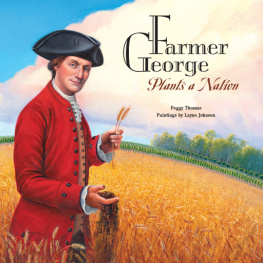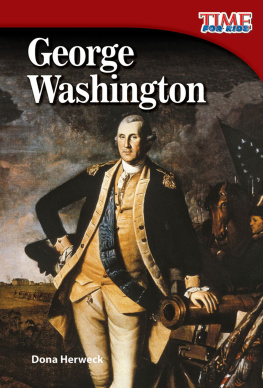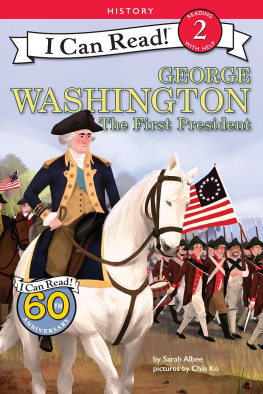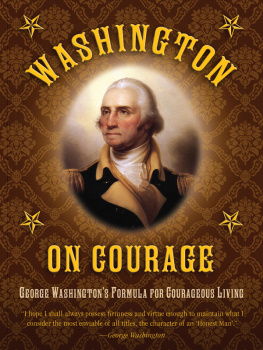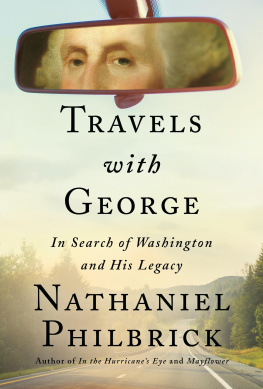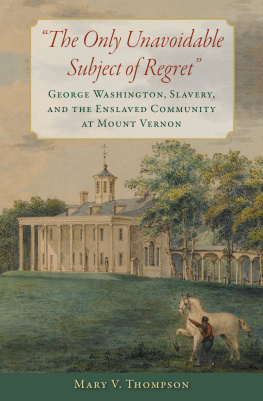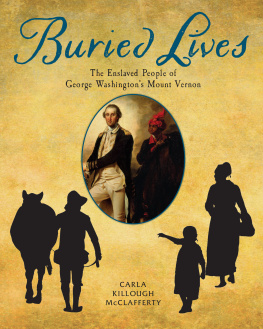G eorge at M ount V ernon
George Washington is most famous for his role as a general in the American Revolution and as the first president of the United States. But he was a general only for eight and a half years and held the office of president for eight years. Most of his time was spent on his land at Mount Vernon, overlooking the Potomac River.
When he leased Mount Vernon in 1754, it covered about two thousand acres. But under his leadership, the estate grew to more than eight thousand acres and was divided into five different farms: Dogue Run, Union Farm, Muddy Hole, River Farm, and Mansion House Farm, where George and Marthas Home House still stands.
George tackled every problem with a courageous spirit and paid close attention to detail. He fought for what he believed in, and was not afraid to try new ideas and experiment with unusual tools. Over his lifetime he renovated the mansion, designed new buildings, changed the way his farms made money, and experimented with more than sixty kinds of field crops and countless more shrubs, vegetables, flowering plants, and trees.
Yes, George loved trees. It was a myth, written after his death, that George chopped down a cherry tree in his youth. In reality, he might have planted more trees than he ever cut down.
Today you can visit Mount Vernon and sit under some of the trees that George planted more than two hundred years ago. Close your eyes, and when you hear the mules braying in their stalls and smell the sweet fragrance of magnolia, you can just imagine Farmer George off in the distance, riding home.
G eorges T houghts on Sl avery
Like most owners of large estates in the 1700s, George relied on slaves to carry out the work on his farms. At the time of his death in 1799, more than three hundred slaves lived and worked at Mount Vernon. They planted, hoed, and harvested the crops, built his barns, cooked his food, washed his clothes, and drew his bath.
Because he had switched from growing labor-intensive tobacco to wheat, which required less work, George actually had more workers than he needed. But George would not sell his slaves. He hated the thought of breaking up families.
... it is... against my inclination... to hurt the feelings of those unhappy people by a separation of man and wife, or of families. (1786)
Although slaves were a normal and accepted part of life in the South during the American Revolution, George came to believe that slavery was wrong.
I never mean... to possess another slave by purchase; it being among my first wishes to see some plan adopted, by which slavery in this country may be abolished by slow, sure, and imperceptible degrees. (1786)
But George kept his concerns to himself. He was afraid that slaveholders in other parts of the country would leave the union if he pushed for the end of slavery. More than anything else, George wanted to preserve the new fragile nation he fought so hard to create. Although George did not promote abolishing slavery publicly, he did take steps as a private slave owner to free his slaves upon his death. He was the only slave-owning president to do so.
L earn M ore A bout F armer G eorge at M ount V ernon
Books
Bial, Raymond. Where Washington Walked. New York: Walker and Co., 2004.
Collier, James Lincoln. The George Washington You Never Knew. New York: Childrens Press, 2003.
Reef, Catherine. Mount Vernon. New York: Dillon Press, 1992.
Santella, Andrew. Mount Vernon. Minneapolis: Compass Point Books, 2005.
Yoder, Carolyn, ed. George Washington the Writer: A Treasury of Letters, Diaries, and Public Documents. Honesdale, PA: Boyds Mills Press, 2003.
Web Site
George Washingtons Mount Vernon Estate & Gardens. www.mountvernon.org. Take a virtual tour of the mansion, and learn about George Washington as a pioneer farmer.
Take a Trip
The best way to get to know George Washington as a farmer is to visit Mount Vernon Estate & Gardens. Explore the Ford Orientation Center and Donald W. Reynolds Museum and Education Center that is tucked below the fields of grazing sheep, and tour George and Marthas mansion home. Stroll through his little garden, and step back in time to the bustle of a working eighteenth-century farm.
The Mount Vernon Estate is located sixteen miles south of Washington, D.C., at 3200 Mount Vernon Memorial Highway, Mount Vernon, Virginia 22121.
Active at the time of publication
B ibliography
Books
Andrist, Ralph K. George Washington: A Biography in His Own Words. 2 vols. New York: Newsweek, 1972.
Colonial Gardens: The Landscape Architecture of George Washingtons Time. Washington, DC: U.S. George Washington Bicentennial Commission, 1932.
Dies, Edward Jerome. Titans of the Soil: Great Builders of Agriculture. Westport, CT: Greenwood Press, 1976.
Ford, Paul Leicester. The True George Washington. Philadelphia: J. B. Lippincott, 1896.
Fusonie, Alan, and Donna Jean Fusonie. George Washington: Pioneer Farmer. Mount Vernon, VA: Mount Vernon Ladies Association, 1998.
Greenberg, Allan. George Washington, Architect. London: Andreas Papadakis Publisher, 1999.
Griswold, Mac. Washingtons Gardens at Mount Vernon: Landscape of the Inner Man. Boston: Houghton Mifflin, 1999.
Meyer, Jeffrey G. Americas Famous and Historic Trees: From George Washingtons Tulip Poplar to Elvis Presleys Pin Oak. Boston: Houghton Mifflin, 2001.
Mount Vernon: An Illustrated Handbook. Mount Vernon, VA: The Mount Vernon Ladies Association, 1974.
Padover, Saul K., ed. The Washington Papers: Basic Selections from the Public and Private Writings of George Washington. New York: Harper and Brothers, 1955.
Twohig, Dorothy, ed. George Washington Diaries: An Abridgment. Charlottesville, VA: University Press of Virginia, 1999.
Articles
Abbot, W. W. George Washington in Retirement. The Lowell Lecture Series, The Museum of Our National Heritage, Lexington, Massachusetts, December 5, 1999. The Papers of George Washington. www.gwpapers.virginia.edu/articles/abbot_1.html.
Boule, John Richard, II. WashingtonEngineer and Engineer Advocate. Engineer: The Professional Bulletin of Army Engineers, JanuaryMarch 2003, 5155.
Chase, Philander D. Thoughts of Home: General Washington Kept a Picture of Mount Vernon in His Minds Eye During the Revolutionary War. 1995. The Papers of George Washington. www.gwpapers.virginia.edu/articles/chase.html.
Kelleher, David. From Malta to Washington: A Gift Fit for a President. The Malta Independent, April 30, 2000.
Pogue, Dennis J. Americas First Composter. Urban Agriculture Notes, February 1997.
Pogue, Dennis J. George Washington and the Politics of Slavery. Historic Alexandria Quarterly, SpringSummer 2003.
Databases and Web Sites
Fitzpatrick, John Clement. The Writings of George Washington from the Original Manuscript Sources. Washington, DC: U.S. Government Print Office, 19311944. http://etext.lib.virginia.edu/washington/fitzpatrick.
George Washington Papers at the Library of Congress, 17411799. www.memory.loc.gov/ammem/gwhtml/gwhome.html.
George Washingtons Mount Vernon Estate & Gardens. www.mountvernon.org.
Active at the time of publication
Artists Note
To create art for this book, I started with one of the best sources, George himself. George Washingtons diaries contain a treasure of information about Georges life, his opinions, and his thoughts on farming. But to gain real insight, I visited George Washingtons homeMount Vernon. As I stood on the piazza of the Virginia mansion, I could almost feel George beside me, looking out over the Potomac. Watching the gentle waters, George might have been contemplating what crops to rotate, how he could improve his barrel seeder, or what trees he would plant down the north lane. With the help of Mount Vernon experts Mary Thompson and Jennifer Lane, I was able to gain a fresh insight into Georges farming world. I watched horses tread wheat in the restored treading barn, feeling the timbers shake as the horses stomped their hooves over the unthreshed grain. Standing in Georges study, I could almost see George sitting at his desk, planning his next project. Anyone can visit Mount Vernon and experience this living historyseeing the beautifully restored mansion the way George and Martha knew it in 1799. I learned that with George Washingtons leadership, innovation, and perseverance, Georges agricultural vision for the country became a reality. As everyone knows, George Washington was a Founding Father, but his legacy as a founding farmer should not be forgotten.

